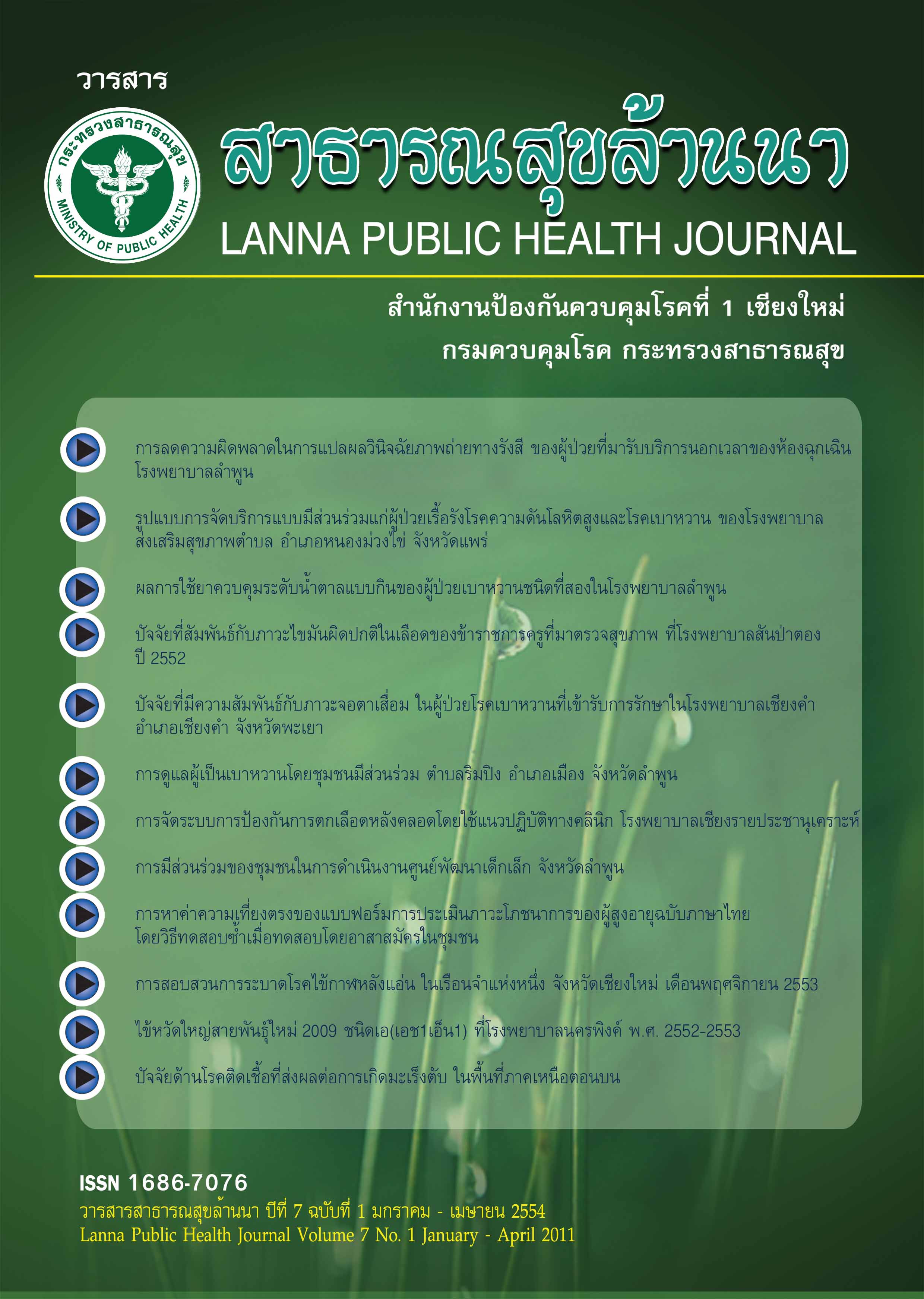ผลการใช้ยาควบคุมระดับน้ำตาลแบบกินของผู้ป่วยเบาหวานชนิดที่สองในโรงพยาบาลลำพูน
คำสำคัญ:
เบาหวาน, ฮีโมโกลบินเอวันซี, การควบคุมระดับน้ำตาลบทคัดย่อ
การศึกษาครั้งนี้ มีวัตถุประสงค์ เพื่อศึกษารูปแบบของการใช้ยาลดระดับน้ำตาลแบบกิน การบรรลุเป้าหมายของการรักษาเบาหวานและปัจจัยที่เกี่ยวข้องในผู้ป่วยเบาหวานชนิดที่สองที่เป็นผู้ใหญ่ ที่มารับการรักษาที่คลินิกเบาหวานของโรงพยาบาลลำพูน ตั้งแต่เดือนมกราคม 2550 ถึง กรกฎาคม 2550 จำนวน 55 ราย พบว่ามีการศึกษาอยู่ในระดับประถมศึกษา ร้อยละ 67.3 ส่วนใหญ่อายุ 40- 59 ปี ร้อยละ 58 มีค่าดัชนีมวลกายเกิน ร้อยละ 45.5 รอบเอวเกินค่าปกติ ถึงร้อยละ 54.5 น้ำหนักตัวมีค่าเฉลี่ย 60.44 กิโลกรัม มีพฤติกรรมสูบบุหรี่ ร้อยละ 98.2 มีความดันโลหิตสูงร้อยละ 50.9 มีไขมันในเลือดสูง ร้อยละ 36.4 ได้รับการรักษาโดยได้รับยากินลดระดับน้ำตาลแบบให้ยาชนิดเดียว โดยให้ยาไกลเบนคลาไมด์มากที่สุด ร้อยละ67 ยาไกลปิไซด์ ร้อยละ24 และยาเมทฟอร์มิน ร้อยละ9 ในผู้ป่วยที่มีภาวะความดันโลหิตสูง จะได้รับยาลดความดันโลหิตร่วมด้วย ผลการควบคุมน้ำตาลในเลือด พบว่ามีเพียงร้อยละ 21.8 สามารถควบคุมฮีโมโกลบินเอวันซี ให้ต่ำกว่า 6.5 % ส่วนลักษณะทางคลินิกอื่นที่เป็นภาวะเสี่ยง เช่น รอบเอว น้ำหนักตัว และค่าดัชนีมวลกายไม่ลดลง แม้ว่าเป้าหมายของการรักษาเบาหวานคือ การควบคุมระดับน้ำตาล ไม่ควรเน้นการรักษาด้านยาเพียงอย่างเดียวมาตรการการส่งเสริมสนับสนุนให้ปรับเปลี่ยนพฤติกรรมเสี่ยงก็เป็นสิ่งสำคัญในการควบคุมระดับน้ำตาลเช่นกัน โดยอาจมีการส่งต่อข้อมูลผู้ป่วยจากโรงพยาบาลตติยภูมิไปยังโรงพยาบาลปฐมภูมิ(โรงพยาบาลส่งเสริมสุขภาพ)ใกล้บ้าน เพื่อให้สามารถจัดกิจกรรมเพื่อปรับเปลี่ยนพฤติกรรมแก่ผู้ป่วย
เอกสารอ้างอิง
Bailey CJ, Dell Prato S, Eddy, Zinman B on ofbehalf of the global partnership for effective diabetes management. Earlier intervention in type 2diabetes: the case for achieving early and sustained glycemic control. Int J Clin Pract 2003; 59: 1309-316.
Hypertention in diabtes Study (HDS): I. Prevalence of hypertention in newly presenting typee 2 diabetic patients and association with risk factors for cardiovascular and diabetic complications. J Hypertens 1993; 11:309-17.
วิชัย เอกพลากร. การประเมินความเสี่ยงต่อเบาหวาน.สถานการณ์สุขภาพประเทศไทย, 2549; 8: 1-6.
UKPDS group. UK Prospective Diabetes Study 6.Complications in newly diagnosed type 2 diabetic patients and their association with different clinical and biochemical risk factors. Diabetes Res 1990; 13: 1-11.
Intensive blood-glucose control with sulphonylureas insulin compared with conventional. Standards of medical care in diabetes. Diabetes Care 2005; n28(Suppl 1): S4-36.
Treatment and risk of complications in patients with type 2 diabetes (UKPDS 33). UK Prospective Diabetes Study (UKPDS) Group. Lancet 1998; 352: 837-53.
Aekplakorn W, Cheepudomwit S, Bunnag P, et al. A risk score for predicting incident diabetes in the Thai population. Diabetes Care 2006; 29: 1872-7.
American Diabetes Association. Standards of medical care in diabetes-2008. Diabetes Care 2008; 31(suppl1): S12-S54.
Clinical Guideline Task Force. Global guideline for type 2 diabetes. International Diabetes Federation 2005.
Natapong K, Sirima M, Nattachet P, et al. Thailand Diabetes Registry Project: Glycemic Control. In Thai Type 2 Diabetes and Its Relation to Hypoglycemic Agent Usage. J Med Assoc Thai 2006; 89 (Suppl 1): S66-71.
Aekplakorn W, Bunnag P, Woodward M, Sritara P, Cheepudomwit S, Yamwong S, et al. A risk score for predicting incident diabetes in the Thai population. Diabetes Care 2006; 29: 1872-7.
H, Saitoh S, Takagi S, Katoh N, Chiba Y, Akasaka H, et al. Incidence of type 2 diabetes in individuals with central obesity in a rural Japanese population: The Tanno and Sobetsu study. Diabetes Care 2006;29:1128-9.
Agardh EE, Ahlbom A, Andersson T, Efendic S, Grill V, Hallqvist J, et al. Work stress and low sense of coherence is associated with type 2 diabetes in middle-aged Swedish women. Diabetes Care 2003;26: 719-24.
Sullivan PW, Morrato EH, Ghushchyan V, WyattHR, Hill JO. Obesity, inactivity, and the prevalence of diabetes and diabetesrelated cardiovascular comorbidities in the U.S., 2000-2002. Diabetes Care 2005; 28:1599-603.








